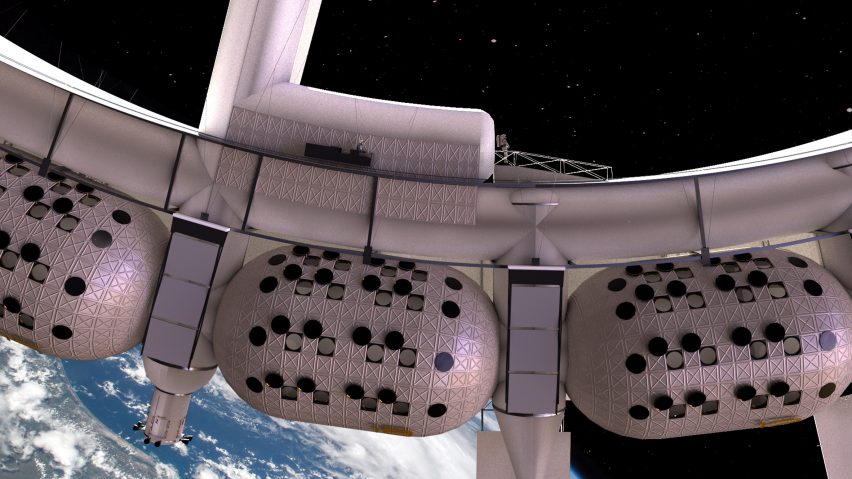Following last week's news that the first space hotel could be ready for guests in 2027, chief architect Tim Alatorre answers questions posed by sceptical Dezeen readers about the project.
The claim that the wheel-shaped space hotel would be constructed in just one year was questioned by several Dezeen commenters.
Others expressed doubts about the way the spinning ring would replicate the effects of gravity through centrifugal force.
But Alatorre, who is chief architect for the project and chief operating officer at space construction firm Orbital Assembly Corporation, reassured readers that the 2027 opening date is achievable.
"This is dependent on everything going to plan, which in space we know things don't always go to plan," Alatorre told Dezeen. "We are pushing for this date."
The biggest obstacle to completion is the availability of rockets powerful enough to ferry components to an altitude of around 2,000km above the surface of the earth, where they will be assembled in low-earth orbit.
"We will need the next generation of launch platforms to become operational," he said.
Rotation "slightly faster than the second hand of a clock"
Guests would not get space sickness in the spinning Voyager Station, Alatorre confirmed.
"We will be rotating at approximately 1.2 revolutions per minute, which is slightly faster than the second hand of a clock," he said.
"Studies have shown that humans can adapt up to as high as 23 revolutions per minute."
Construction of the 400-person hotel will begin on Earth in 2023. "Significant portions will be constructed on the ground and then assembled in orbit," Alatorre said.
Assembly of the outer ring, which will hold the hotel's habitation modules, is due to start in space in 2025.
The 50,000-square-metre space hotel will eventually have 24 modules, although the hotel can begin operating once four of them are in place.
"Our plan is to start the construction of the outer ring truss in 2025," said Alatorre. "We can start the operation of the station with only four modules in place. This is our 2027 target."
Below is the Q&A with Alatorre:
Tom Ravenscroft: Do you think that the 2027 opening date is realistic?
Tim Alatorre: Our development roadmap is planned for a 2027 initial operation date. This is dependent on everything going to plan. In space, we know things don't always go to plan. We are pushing for this date.
Tom Ravenscroft: What are the main obstacles to this happening?
Tim Alatorre: The primary obstacle is heavy-lift launch capabilities. Our initial steps could be done with existing capabilities but we will need the next generation of launch platforms to become operational.
Tom Ravenscroft: The start date for construction was reported as 2026 with completion in 2027. This seems ambitious.
Tim Alatorre: Our plan is to start the construction of the outer ring truss in 2025. We can start the operation of the station with only four modules in place. This is our 2027 target.
Tom Ravenscroft: Will construction involve a lot of on-earth prefabrication?
Tim Alatorre: Yes. Significant portions will be constructed on the ground and then assembled in orbit. I expect the first sections should begin fabrication towards the end of 2023 or early 2024.
Tom Ravenscroft: How is the space hotel being financed?
Tim Alatorre: A combination of equity financing, pre-sales and investment capital.
Tom Ravenscroft: How will gravity be created within the hotel?
Tim Alatorre: We can't create true gravity but we will create artificial, or simulated, gravity through rotation. As the station rotates, the occupants feel centrifugal forces, which creates the effect of gravity.
Tom Ravenscroft: Is there a chance that people will get space sick?
Tim Alatorre: Space sickness is caused by microgravity (zero gravity) and may occur while travelling to the station but is dependent on a number of factors.
Tom Ravenscroft: How will it feel to be in a spinning hotel room?
Tim Alatorre: The station will have 1/6 Earth gravity. We will be rotating at approximately 1.2 revolutions per minute, which is slightly faster than the second hand of a clock. Studies have shown that humans can adapt up to as high as 23 revolutions per minute.
By using a low rate of rotation, we hope the adaptation period will be very short. Occupants will notice effects of the rotation but not to impairment of motion or comfort.

